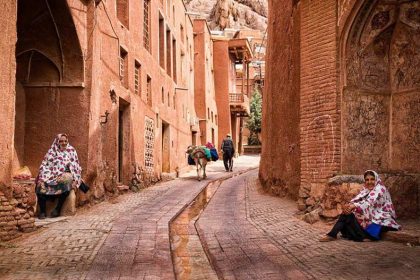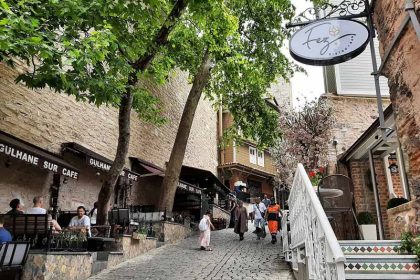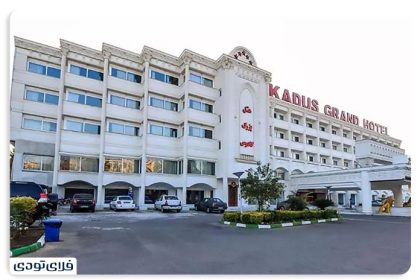The route of the Silk Road includes many places of interest from Turkey to China that catch the eye of every tourist.
The Silk Road included a vast geographic network that encompassed mountains, deserts, cities, and seas. This term is in an aura of legend and reality; But its name still attracts the attention of tourists. From Europe to Asia, there are countless extraordinary places along this network of roads that capture the attention of every passerby.
In this article, 10 places of interest on the Silk Road have been selected, of course, a handful are examples of Kharwar. Some of these places are located in war-torn lands today and it is not easy to visit them; For this reason, they are not among the tourist destinations of travelers; However, considering their historical importance, it was important to mention them.
Sights of the Silk Road:
Old city of Damascus, Syria
Damascus is considered one of the oldest cities in the world where humans have continuously inhabited. Over the centuries, this old city has seen many invaders, including Greeks, Abbasids and Seljuk Turks, and of course many curious tourists. Decorative swords and braids were among the famous handicrafts of this city. Damascus silk was originally made in China; But because this silk was traded in Damascus, it got this name.
In 2013, the Old City of Damascus was added to the UNESCO World Heritage List in Danger
“old city of Damascus” is the historical part of the Syrian city of Damascus. In the old city, there are numerous archaeological sites, including several historical churches and mosques. “Umayyad mosque” or “Great Mosque of Damascus” is one of the most impressive sights of the old city of Damascus.
The Jame Mosque of Damascus dates back to the Umayyad period in the early Islamic centuries; That is, when the Umayyads chose Damascus as their capital in 661 AD. After the start of the Syrian civil war, the old city of Damascus was added to the UNESCO World Heritage List in 2013.
Photo credit: Getty Images, photographer: Wirestock
Ishaq Pasha Palace, Türkiye
“Ishak Pasha Palace” is located on a large and separate rock, near the city of “Dogubayazit” (Dogubayazit) in eastern Türkiye. Ishaq Pasha was a palace and an office complex that has turned into a semi-ruined structure today. This bright and impressive palace has a brick dome and minaret and has a combination of Ottoman, Persian and Seljuk elements.
The architecture of Sarai Ishaq Pasha is a combination of Ottoman, Iranian and Seljuk elements
Ishaq Pasha’s family was the ruler of Dagbeyzid region and ordered the construction of the palace. The construction of Ishaq Pasha Palace started in 1685 AD and was completed in 1784, i.e. after the era of the Silk Road. Its lofty position overlooks the surrounding areas and was at the intersection of the ancient silk road network on the way to Georgia and Iran and the caravan route from Tabriz to the Black Sea ports.
The road leading to Ishaq Pasha’s residence also passes through the ancient Bayezid fortress near Mount Ararat; The place where the merchants of the Silk Road used to stop and store their goods.

Photo source: Getty Images, photographer: Ozbalci
Salim Caravanserai, Armenia
“Selim Caravanserai” of Armenia is sometimes known by the name of its founder’s family, namely “Orbelian’s Caravanserai”. Salim was an inn for merchants, which was completed in 1332 AD. This caravanserai is located on the remote route of Selim Pass in the south of Armenia, in Vayots Dzor province.
Salim Caravanserai is the healthiest caravanserai in Armenia
Erbelian is a long, low and dimly lit caravanserai with only one entrance door. The single entrance door was a good barrier to prevent thieves from entering and the bitter cold of winter. The entrance of the caravanserai is decorated with a bull and a lion. As soon as you enter the caravanserai, you can easily imagine how merchants used to gather under one arch and their animals under another arch.
Salim Caravanserai is located in the old international trade crossing and near the border of Iran. Today’s travelers also have good access to this caravanserai; Because the caravanserai is located on one of the footpaths of the Caucasus. Driving to Selim Caravanserai is also possible. Erbelian Caravanserai is considered the healthiest caravanserai in Armenia.

Photo source: eltravelclub.am, photographer: unknown
Oplistsikhe, Georgia
The stone city of “Uplistsikhe” (Uplistsikhe) in the eastern part of present-day Georgia was once located next to the Silk Road network. This city is carved in the heart of the rocks and was once a prosperous trading city. Oplistsikhe is one of the oldest settlements in the Caucasus, located about 10 kilometers east of the Georgian city of Gori, the birthplace of Stalin.
Most of the ancient city of Oplistsikhe was razed to the ground by the Mongols in the 13th century
In the 6th century BC, Oplistsikhe, on the rocky bank of the “Kura” river, was gradually carved into the heart of the hard rocks and turned into a large and central religious city. Various structures from the Iron Age to the Middle Ages can be seen there.
Today, the remnants of the inner city of Oplistsikhe remain, once home to around 20,000 people, with a market, temple, palace, bakery and sewers. Considering the remains of the foundations of the city, one can easily imagine the daily life of its citizens. Other parts of the ancient city of Oplistsikhe were razed to the ground by the Mongols in the 13th century.

Photo Source: Georgian Travel Guide, Photographer: Unknown
Tabriz, Iran
The old market complex of Tabriz consists of a network of interconnected markets in an area of more than 100 hectares, which is also registered in the UNESCO World Heritage List. This covered market is located under domes and brick arches, and in it, goods such as leather, silver, copper, spices and carpets are sold.
Tabriz market dates back to the 10th century. Due to its strategic location and tax exemption, this market was one of the most important commercial, gathering and educational centers on the Silk Road. Today, the Tabriz market is considered a living example of the culture of the Silk Road, where artisans, artists, tobacconists, tailors, calligraphers, and writers from different cultures work in its ranks.

Photo source: Alamy, Photographer: Image Professionals
Merv, Turkmenistan
The old city of Merv, in the “Mary” region of Turkmenistan, has been a human settlement since the Bronze Age, that is, from the 3rd millennium BC to the 18th century AD. During the Achaemenid period, Mero was the capital of the “Margiana” state, and since then it has changed hands between different powers. In this city, there were many fortifications, mosques and tombs, of which less remains can be seen today.
The city of Mero was the third largest city in the world in the 10th century AD
According to some historians, the city of Mero was the third largest city in the world in the 10th century; But this is not the whole story. This city was once one of the most important cities in the Islamic world that attracted merchants, scientists and tourists from far away places.
Today, the city of Merv is considered one of the oldest cities on the Silk Road in Central Asia. The tomb of Sultan Sanjar, belonging to the 12th century and recently restored, is one of the landmarks of the Silk Road and a rare example of Seljuk memorial architecture. A visit to the Mari regional museum with works such as Seljuk bronze vessels and Mongolian pottery is also recommended.

Photo Source: Islamic Architectural Heritage Database, Photographer: Unknown
Tirmaz, Uzbekistan
The city of “Termez” is the southernmost city of Uzbekistan, located on the banks of the ancient Amu Darya River. This city became an important commercial center when it was under the rule of the ancient Kushan Empire (1st century AD). The Kushan Empire extended from North India to Afghanistan and parts of Central Asia. This empire promoted trade and not only the exchange of goods, but also the Silk Road style, the exchange of handicrafts, ideas and religious renewal.
Fayaztepe Buddhist monastery reminds of scenes from the Star Wars movie
Today, Tirmaz hosts tourists interested in the Silk Road, who come to the area to visit ancient Buddhist sites. “Fayoz Tepe” Buddhist monastery, 15 kilometers west of Tirmaz, is the most visited attraction of this city. This monastery has a sand-colored dome and a shape and size similar to an Eskimo hut, and in this sense, it reminds of scenes from the Star Wars movie.
Fayaztepe Buddhist complex was built in the 1st century AD and reached the peak of its activity in the 3rd and 4th centuries AD. Around the Fayaztepe platform, remains of meditation halls, kitchen, rest room and ancient water channels can be seen. The city of Tirmaz has a good museum containing ancient artifacts of the region.

Photo source: Alamy, photographer: Suzuki Kaku
Taxila, Pakistan
The ancient city of “Taxila” (Taxila) in the Punjab region of Pakistan is registered in the UNESCO World Heritage List and has amazing architecture. From the city of Islamabad, you can easily drive a distance of 25 kilometers in the northwest direction and reach this ancient site. This mason city was located at the intersection of the silk roads and was one of the old centers of “Gandhara” (one of the Achaemenid satrapies); The territory that was located between the two rivers “Oxus” (Oxus) and Indus.
In the huge area of Taxila, there is a cave belonging to the Mesolithic age; But more importantly, there are Buddhist monuments and remains of monasteries scattered throughout the Taxila valley, which testify to the fact that Taxila was once a religious center and a destination for pilgrims and monks who came to the area from China and Central Asia. The Taxila City Museum is located near the historical center of the city and houses at least 2,000 valuable objects.

Photo Source: Hunza Guides Pakistan, Photographer: Unknown
Issykkol, Kyrgyzstan
“Issyk-Kul” lake is located among the mountains and sea buckthorn bushes and former Soviet sanatoriums, and was once a meeting place for commissioners and astronauts; But today it is a place for sunbathing and swimming for Kazakhs, Russians and Kyrgyz in the summer. Issykkol is a saltwater lake located in the east of Kyrgyzstan and is considered the eighth deepest lake in the world. Once upon a time, a branch of the Silk Road passed through this lake, known as Nagin of Kyrgyzstan, and reached the border of Kashgar in Xinjiang province or Uyghuristan, China.
For more than 2,000 years, Kashgar was the hub of trade and cultural exchange in the region and was full of teahouses, mosques, and bazaars. Today, most parts of old Kashgar, as well as other Uyghur cities, have been destroyed or irreparably changed, and Beijing’s brutal repression of the Uyghur people continues.

Photo source: Getty Images, photographer: FotoVSmirnov
Dunhuang, China
“Dunhuang” (Dunhuang) is an oasis and a pilgrimage site in northwest China and includes the “Mogao Caves”. This oasis has a crescent-shaped lake and singing dunes. Dunhuang is considered one of the most important collections of Buddhist art in the world. Holy chambers and places have been dug in the heart of the rock facing the river. Dunhuang wall paintings illustrate the story of the Silk Road from the 4th to the 14th century.
Dunhuang is in a strategic position in the middle of the route from India to Mongolia and southern Siberia. More than 500 caves are preserved in Dunhuang, in which there are countless wall paintings and more than 2,000 colorful sculptures. Cave No. 302 from the Sui Dynasty period (581 to 619 AD), specifically contains a pattern of the Silk Road; Balkhi’s two-humped camel is carrying a cart in which the merchant is sitting.

Photo Source: South China Morning Post, Photographer: Unknown
If you have visited the places of interest on the Silk Road, share your experience with us and other Kajaro companions.
Cover photo: Crescent Lake of Dunhuang Oasis, China; Photo credit: Getty Images, photographer: Feng Wei
Frequently asked questions
What are the most important sights of the Silk Road?
The old city of Damascus in Syria, Sarai Ishaq Pasha in Turkey, Selim Caravanserai in Armenia, Oplistsikhe in Georgia, Tabriz, Merv in Turkmenistan, Termez in Uzbekistan, Taxila in Pakistan, Isikkol in Kyrgyzstan and Dunhuang in China are some of the most important sights of the Silk Road. .
Why is the old market of Tabriz famous?
The old market of Tabriz was one of the most important commercial, gathering and educational centers on the Silk Road due to its strategic location and tax exemption. This market, which is still a living example of the Silk Road culture, has been registered in the UNESCO World Heritage List.
RCO NEWS

















